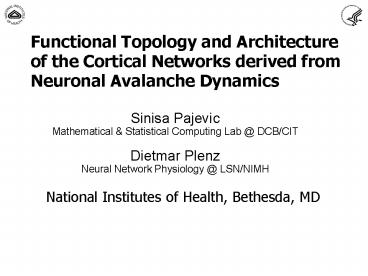The canonical basal ganglia circuit - PowerPoint PPT Presentation
1 / 23
Title:
The canonical basal ganglia circuit
Description:
Pairs of active nodes are shuffled across the raster, while preserving the ... Normalized count with paired-shuffling performs best in reconstructing the ... – PowerPoint PPT presentation
Number of Views:39
Avg rating:3.0/5.0
Title: The canonical basal ganglia circuit
1
Functional Topology and Architecture of the
Cortical Networks derived from Neuronal Avalanche
Dynamics
Sinisa Pajevic Mathematical Statistical
Computing Lab _at_ DCB/CIT Dietmar Plenz Neural
Network Physiology _at_ LSN/NIMH
National Institutes of Health, Bethesda, MD
2
Neocortex and Cortical Networks
cortical sheet
2 mm
Columnar organization
Cajal, 1894
I
II
III
IV
V
VI
Micro-circuit level
Brain level circuitry
Probabilistic rules of neuronal connectivity at
micro-circuit level are still unknown (quadruple
whole cell recordings, glutamate uncaging, etc.)
3
In-vitro Experimental Setup
- Organotypic Cultures from 1-2 days old rat brains
- Acute Slices from adult rat
cut
Rat brain PD 1-2
4
Neuronal Avalanches Are Defined by a Power Law
in Sizes With Slope 1.5
branching process, s?1
Beggs,J.M. Plenz,D. Neuronal avalanches in
neocortical circuits. J. Neurosci. 23,
11167-11177 (2003).
5
Clustering of Neuronal Avalanche Patterns
Similarity matrix
160
After4 hrs
high
1
low
160
1
Clustering analysis reveals similar patterns
(beyond random chance)
Avalanche A
Neuronal Avalanches Patterns have the underlying
structure! Model avalanches as a branching
process on top of the underlying functional
network.
24 min
Beggs JM, D Plenz (2004), Journal of Neuroscience
24, 5216-5229.
0 ms
4 ms
12 ms
16 ms
6
Topology of Complex Networks
Disparate complex systems exhibit common features
regarding the topology of the interactions
(represented as links) among their basic
constituent parts (represented as nodes).
Small world property of a network 1. Network
is sparse 2. Short average node-to-node
distance, dlnN 3. Highly clustered.
Clustering coefficient (CC), indicates a
probability that any two neighbors of some node
are connected.
?
?
?
Small world topology enables specialization,
synchronization and redundancy locally, and most
efficient information flow both locally and
globally.
Topology vs Architecture
7
GOALS
- Reconstruct the functional network from the
neuronal avalanche raster - Characterize its topology and architecture.
In-Vitro MEA Recordings in Rat cortex
acute coronal slice, rat frontal cortex
LFP
LFP
mPFC
electrode
D
t (1 ms 6 ms)
Avalanche size
s
5
electrodes
1
time
ventral
8
Reconstructing Functional Network
Topology If a source node s can cause activation
of a target node t, then a directed link from s
to t exists
Architecture wst number of activations of the
target node t caused by node s
9
(No Transcript)
10
Simulations
Network Models
- Erdös-Rényi random network (ER)
- Watts-Strogatz small world network (WS)
- Ozik-Hunt-Ott growing network (OHO)
- Barabasi-Alberts scale free network (BA)
- WS and OHO are highly clustered BA and OHO are
growing networks
Simulating Avalanche Dynamics
k
Each link assigned a probability of activating
the target node. Initial activation propagates
based on these probabilities, with refractory
period taken into account.
j
pik
pij
i
11
How well can we reconstruct structural topology?
Reconstruction on simulated rasters with 20
noise, and for three dynamical regimes,
sub-critical, critical and super-critical
sub-critical
critical
super-critical
100
)
ER
(
r
o
10
r
SA
r
e
Bayes
NC Shuffle
1
2
3
3
3
4
4
4
10
10
10
10
10
10
10
estimation steps (n)
12
How well can we reconstruct network architecture?
Pearson 0.96 0.02 when avalanche activation
sites are uniformly distributed Pearson 0.93
0.02 when non-uniformly distributed (shown below)
ER
BA
OHO
WS
Reconstructed link weights
Link activation probabilities
13
Randomization of Network
- Total Randomization (TR)
- Create a random network with the same number of
nodes and the same number of edges - Degree Sequence Preserving Randomization (DSPR)
- For directed networks, choose a pair of edges
with distinct nodes and switch them
B
A
C
D
14
Experimental and Simulation Results
Clustering Coefficient (C)
Mean node-to-node distance
0.8
OHO
Natural
DNQX
0.6
2
PTX
WS
BA
WS
ER
OHO
PTX
0.4
Natural
DNQX
BA
1
ER
0.2
Simulations
Experiment
0
0
Original Network Estimate
DNQX - Dinitroquinoxaline
Degree Seq. Pres. Randomization (DSPR)
PTX - Picrotoxin
Total Randomization (TR)
15
Three-node motifs
Milo et al, Science, 298, 824, 2002
16
Motif Counts (Ratio to DSPR)
N/NDSPR
17
Motif Counts (Ratio to DSPR)
N/NDSPR
18
Summary of motif counts
non-existent
very rare
abundant
15
19
Interpreting these basic motifs
Synchronous activity propagation
Hebbian Learning
20
Motif geometry
Single node neighbors
Motif 11,12 lattice distances
21
Reciprocal Links vs Directed Links
Average distances between nodes with different
link types Single directed links (blue) and
reciprocal links (red)
Single link
Double link
22
Summary
- Normalized count with paired-shuffling performs
best in reconstructing the underlying network
topologies from observed avalanche dynamics. - Functional cortical network reconstructed from
avalanche dynamics reveal small world topology - Motif analysis demonstrates that mutually coupled
neuronal groups receive common inputs or converge
onto common groups, and also the abundance of
reciprocal connections. - Cortical architecture is characterized by
increased clustering with stronger links,
preserving small world property at all activity
levels.
23
The End































